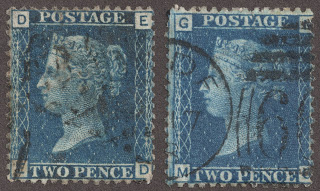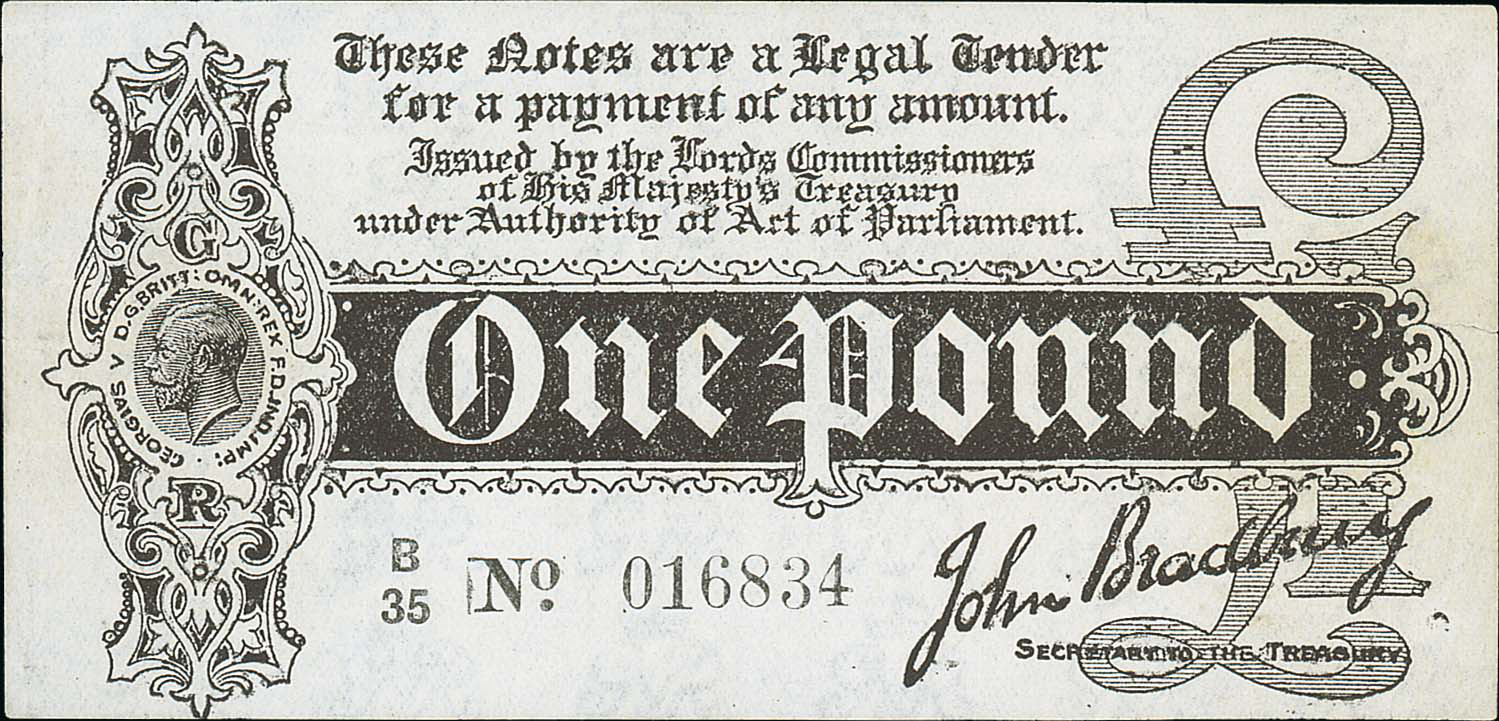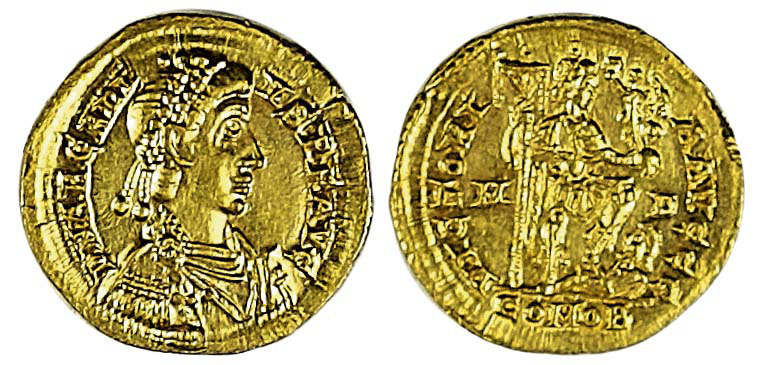The Penny Black is renowned for being the world’s first stamp. It’s undoubtedly the most famous of all stamps - and one which every collector aspires to own.
Famed for its fine engraving and timeless simplicity, this beautiful stamp has an intriguing philatelic history.
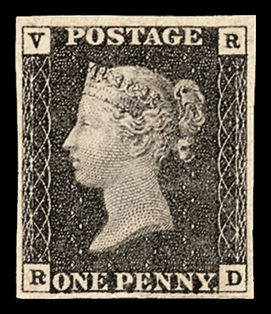
Sir Rowland Hill & a Penny Black revolution
In the 1830s, British postal rates were high and the charges were complex to understand. Usually, the recipient paid for postage upon delivery, with the charge determined by weight and distance travelled.
To make matters easier for the Post Office and public, Sir Rowland Hill proposed using an adhesive stamp to indicate postage had been pre-paid.
Although he put forward his idea in 1837, it was not until three years later on 1 May 1840 that the Penny Black was first issued in Great Britain - even though it was not valid for use until 6 May.
Featuring a profile of Queen Victoria, the Penny Black was the world's first adhesive postage stamp to be used in a public postal system. This historic stamp allowed people to send letters weighing up to half an ounce (14g) to be delivered for the flat rate of one penny, regardless of the distance travelled.
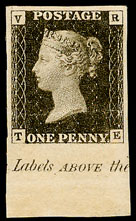
This VR 4 margined single is enhanced by the marginal inscription. It realised £5,782 in a Warwick & Warwick auction in April 2015.
An infamous inscription
The Penny Black was inscribed in capital letters with the word ‘POSTAGE’ at the top and ‘ONE PENNY’ at the bottom. Its background was made up of finely-engraved engine turnings.
Its upper left and right corners featured two star-like designs, with the lower left and right corners containing letters, which helped to designate the position of the stamp in relation to the sheet on which it was printed (see below). It was printed in sheets of 240 by Perkins Bacon.
Interestingly, the image of Queen Victoria which was used on Penny Black was based on a sketch of her aged 15. However, it was to remain on stamps for the entirety of her reign - which lasted almost 64 years until she died at Osborne House on the Isle of Wight, on 22 January 1901.
How many Penny Black stamps are there in the world?
With more than 68 million produced during a one-year print run, the Penny Black is not exactly a rare stamp.
Most experienced stamp collectors are aware of this, but it is often something of a surprise to the uninitiated.
A total of 286,700 sheets – containing 68,808,000 stamps – were made available and around 1.3 million are estimated to still exist. This 2% survival rate is probably higher than you would expect because the use of envelops was unusual in the 1840s.
Consequently, the stamp and the address could be found on the obverse of a letter, which was folded and sealed with wax after being written.
Blocks of Penny Blacks are very rare and strips are also scarce. The British Postal Museum, in London, is the only known owner of a complete sheets of Penny Black stamps.
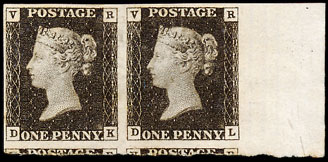
This attractive marginal pair of the VR Official realised £17,110.
The most desirable Penny Black for a collector would probably be one posted on 6 May 1840 – a first day cover of distinction.
However, all Penny Blacks posted with a May 1840 date are extremely collectable, particularly those with Sunday dates (10, 17, 24 and 31). Interestingly, there are fewer covers recorded for May 7 and 8 than for the 6th. But in terms of value, they are worth a fraction of the price.
How Penny Black plates affect rarity
Printed from engraved steel plates in sheets of 240, each Penny Black stamp came embossed with a small crown watermark. The gummed paper was imperforated and each Penny Black was cut from the sheet with scissors.
Each sheet contained 240 letter combinations, starting with AA at the top left and going down to TL at the bottom right (see below).
Such was the demand for the Penny Black that the printing plates soon showed signs of wear and needed repairing or replacing.
In total, 12 different plates were used to keep up with demand - including two versions of the first plate (1a and 1b), which required extensive renovation because of excessive wear.
As outlined in the table above, the rarest Penny Blacks came from plate 11 from which only 168,000 stamps were produced. This plate was originally created to print the Penny Reds which were set to replace the Penny Black. However, when the red ink was not ready, they continued to use black ink for a 700-sheet run.
Experienced collectors can ‘plate’ a Penny Black and assign it to a particular position on the plate by using small identifying marks and other little characteristics including:
- The individually ‘punched’ corner letters (see below for more detail).
- Positioning of corner letters within their squares.
- No two pairs of letters are ever in precisely the same position.
- Characteristics of the stars in the upper corners.
- Presence of the ‘O flaw’.
- Guide line flaws.
- Double corner letters.
As a result of the development of these flaws, stamps in different states may exist from the same plate.
Penny Black collectors are always interested in these ‘varieties’ and there may be more than one ‘state’ for one corner letter and plate combination.
Sought-after Penny Black cancellations
As outlined in our Stamp Grading and Condition guide, the cancellations which were used are almost as interesting to philatelists as the stamp itself. This is certainly applicable to the Penny Black, which was supposed to be cancelled using red ink and the standard ‘Maltese Cross’ postmark (picture below).
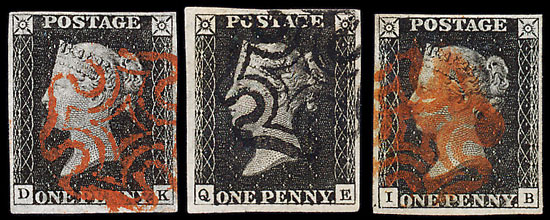
However, because every postmaster across the UK had to mix their own cancelling ink, there are Penny Blacks which have been struck with the Maltese Cross in shades of ruby, brown, magenta, orange and blue. These are highly desirable to collectors.
In some cases, the original cross supplied by the Post Office became damaged or was lost, so postmasters created their own copies. These are known by collectors as ‘distinctive’ crosses, are rather uncommon and much prized by collectors.
The cross used by the postmaster at Wotton-under-Edge in Gloucestershire is very distinctive and among the most famous of cancellations.
How much is a Penny Black stamp worth?
Condition and appearance have a major influence on the price of a rare stamp. A mint or unused stamp is usually worth much more than one which is used or in poor condition. Penny Black stamp values are no different.
In our experience, the value of a Penny Black stamp depends on three main factors:
Physical condition: Faults like tears, creases, stains or thinning lower the value substantially.
Plate used: Some are rarer than others (plate 11).
Appearance of white margins: The size, number and regularity make a major difference to value.
So, what’s the effect on Penny Black prices?
As with most collectables, it’s impossible to put an exact value on an item’s worth unless it is professionally valued by one of our experts.
However, in 2019, a Penny Black can cost as little as £15 to £30 if it’s in poor to reasonable condition.
You might have to pay between £40 to £150 for a specimen of better quality, whereas a fine used example could fetch around £250 to £400.
Obviously, an unused Penny Black which is in ‘mint’ or ‘very fine’ condition is worth considerably more – ranging from around £1250 to five or six-figure sums.
Because Penny Blacks were not perforated, and needed separating using scissors or a knife, irregular margins were not uncommon and collectors will pay higher prices for an exceptional example with four regular, wide and even margins.
During April 1840 a supply of Penny Blacks was printed with the check letters VR in the upper corners instead of the usual stars. The intention was to issue the stamps to government offices but the scheme was abandoned and most of the sheets destroyed. A few sheets survived, however, and examples of the Penny Black VR official are very rare.
Back in 2015 we sold an 1840 Penny Black VR official block of 4 (picture below) and a pair amongst a specialist section of Penny Blacks.
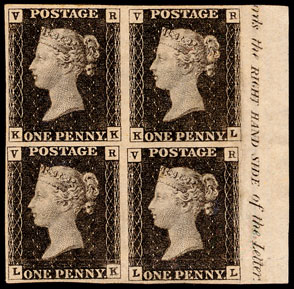
The highlight of the Penny Black auction was the VR official block of 4 (pictured above) which sold for £31,860, with the pair achieving £17,100 and the single realising £5,800. An 1840 1d black plate 1b unused sold for £1,300 and an 1840 2d blue plate 1 unused pair also for £7,080 on the same day.
Have you found a rare Penny Black? Get a fast and accurate Stamp Valuation from our experts or read our How to appraise stamps guide today!
The lasting Penny Black legacy
The fact that the Penny Black stamp is still in extremely high demand more than 150 years after it was first produced is a testament to its popularity.
It may have been small, but this rectangular piece of gummed paper left a lasting legacy for 6 main reasons:
- It was the world’s first adhesive stamp.
- Made sending letters affordable.
- Changed the way the world communicated.
- Developed new ways to process and deliver mail.
- Unified the price of sending letters.
- Encouraged people to read and write.
Despite its fame, the 1d black postage stamp was considered a relative failure because the thrifty and ingenious Victorians quickly came up with ways to reuse the stamps by washing off the cancellation.
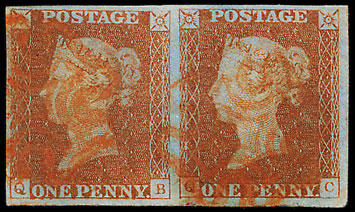
However, even though it was superseded by the Penny Red (pictured above) in 1841, the British public – and stamp collectors in particular – refuse to let their love affair with the Penny Black diminish. To this day it remains one of the most popular stamps in the world.
If you’ve inherited or acquired a Penny Black, please get in touch or call 01926 499031 for a free, fast and accurate valuation – our stamp experts will be happy to help.



